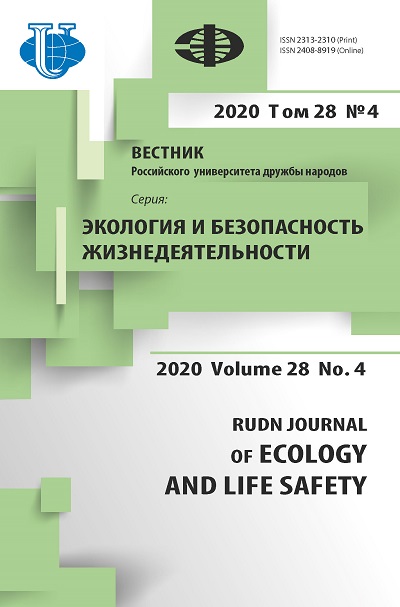Assessment of the open-mining prevalence on the territory of Moscow region
- Authors: Naumova K.O.1, Stanis E.V.1
-
Affiliations:
- Peoples’ Friendship University of Russia (RUDN University)
- Issue: Vol 28, No 4 (2020)
- Pages: 349-360
- Section: Geoecology
- URL: https://journals.rudn.ru/ecology/article/view/27349
- DOI: https://doi.org/10.22363/2313-2310-2020-28-4-349-360
Cite item
Full Text
Abstract
Lands disturbed by open cuts and associated dumps often become unsuitable for further use as construction sites. Disturbed lands are technogenically altered soils with new changed physicomechanical and physicochemical properties. The paper examines the results of researching the disturbed lands of common mineral resources open cuts in Moscow region, provides a description of the causes and types of land disturbance, as well as examples of images of disturbed lands on satellite images. For this purposes, thematic and topographic maps and remote sensing materials - satellite images of the territory of the Moscow region were used. The problems of impact of common mineral resources extraction on the natural complexes in the region, the scale of technogenic transformation of the earth surface as a result of open cuts mining as well as the geoecological problems arising in this case are considered. Numerical geoecological assessment of sand quarries in Moscow region is also given.
About the authors
Ksenia O. Naumova
Peoples’ Friendship University of Russia (RUDN University)
Author for correspondence.
Email: shunenkova-ko@rudn.ru
student, Department of Geoecology, Faculty of Ecology
6 Miklukho-Maklaya St, Moscow, 117198, Russian FederationElena V. Stanis
Peoples’ Friendship University of Russia (RUDN University)
Email: stanis-ev@rudn.ru
SPIN-code: 3964-3144
Ph.D. of Technical Sciences, Associate Professor, Head of the Department of Geoecology, Faculty of Ecology
6 Miklukho-Maklaya St, Moscow, 117198, Russian FederationReferences
- Darwish T, et al. Environmental impact of quarries on natural resources in Lebanon. Land Degradation & Development. 2011;22(3):345–358.
- Bubnova OA. Recovery soil properties are violated mining. Geotechnical Mechanics: Interdepartmental Collection of Scientific Papers. Dnepropetrovsk: IGTM NASU; 2011. p. 94. (In Ukranian.)
- Kalieva KB, Ishkenov BT. Impact on the environment of opencast mining. Innovative Science. 2017;(11):33–37. (In Russ.)
- Kurchin GS, Volkov EP, Zaytseva EV, Kirsanov AK. Environmental problems in the extraction of nonmetallic building materials in Russia. Modern Problems of Science and Education. 2013;(6). (In Russ.) Available from: http://science-education.ru/ru/ article/view?id=10500 (accessed: 10.10.2020).
- Nazarenko NV, Petin AN, Furmanova TN. Effects development of deposits common mineral resources on the environment. Modern Problems of Science and Education. 2012;(6):610. (In Russ.)
- Tazhetdinova NS, Iolin MM. Geoecological assessment and control of anthropogenic impact during the extraction of mineral raw materials. Geology, Geography and Global Energy. 2011;(2):235–242. (In Russ.)
- Stanis EV, Ogorodnikova EN, Karpukhina EA. Changing in the parameters of dumps of coal-mining industry of Kansr-Achinsk (Siberian) coal field and possibility of their remediation. International Symposium on Geoenvironmental Engineering. 2009:103–105.
- Vondráčková T, et al. The fracturing of rock mass and its risks to engineering objects. Procedia Earth and Planetary Science. 2015;15:60–65.
- Hasanova NYu. Features of the deformation processes of the slopes of the sides of deep quarries, composed of fractured rocks. Problems of Science. 2017;6(19):20–22. (In Russ.)
- Shpakov PS, et al. Influence on stability fractured pit and its variability in size and depth on Gorevsky field. Gorny Information and Analytical Bulletin. 2015;(11):32–40. (In Russ.)
- Zakirt Hossain GM, Saumitra Narayan Deb, Stanis EV, Mashkovtsev IL. Protection of the geological environment from the influence of underground mining. In: Resource-Reproducing, Low-Waste and Environmental Technologies for the Development of Subsoil. Moscow: RUDN Publ.; 2004. p. 71. (In Russ.)
- Murasheva AA, Mazepo AA, Lepekhin PP. Legal problems of subsoil use affecting the development of a “green” economy in the Russian Federation on the example of the Moscow region. Moscow Economic Journal. 2017;(2):32. (In Russ.)
- Makarova NV, Grigorieva SV. Geomorphological zoning of the territory of Moscow within new boundaries. Geomorphology. 2019;(4):56–68.
- Sviridova TV, et al. Ensuring the stability of the slopes of the pit walls to prevent accidents and emergencies. Vestnik of Nosov Magnitogorsk State Technical University. 2016;14(4):5–10. (In Russ.)
- Lavrusevich A, Abene A, Lavrusevich I. Geoecological aspects of technogenic impact on the territory of raw materials production for construction. MATEC Web of Conferences. 2019;265:06013.
- Rudko GI, Shekhunova SB, Shimansky LI. Modern natural and technogenic processes in the zone of influence of the Krivskoe gypsum quarry (border area of Ukraine and Moldova). Geoecology. Engineering Geology, Hydrogeology, Geocryology. 2004;(3): 257–264. (In Russ.)
- Ashikhmina TV, Ovchinnikova TV, Fedyanin VI. Environmental pollution during the deposition of solid household waste. Fundamental Research. 2009;7:78–80. (In Russ.)
- Kozlovsky AA, Khomenko NN. Use of the mined-out space of a quarry as a landfill for storage of industrial waste. Gorny Information and Analytical Bulletin. 2010;(9): 285–288. (In Russ.)
- Marynych SN, Kolmykov SN. Noise pollution in areas where chalk is mined and processed by an open method (on the example of OJSC “Shebekino-Mel”). Modern Trends in the Development of Science and Technology: a Collection of Scientific Papers Based on the Materials of the VII International Scientific and Practical Conference (31st October 2015). Belgorod; 2015. p. 133–135. (In Russ.)
- On the state of natural resources and the environment of the Moscow region in 2018: information release. Krasnogorsk; 2019. (In Russ.)
- Buchkin MN, et al. (comps.) Natural resources of the Moscow region: atlas. Moscow; 2008. (In Russ.)
- Danshin BM. Geological structure and minerals of Moscow and its environs. Moscow: MOIP Publ.; 1947. p. 308. (In Russ.)
















